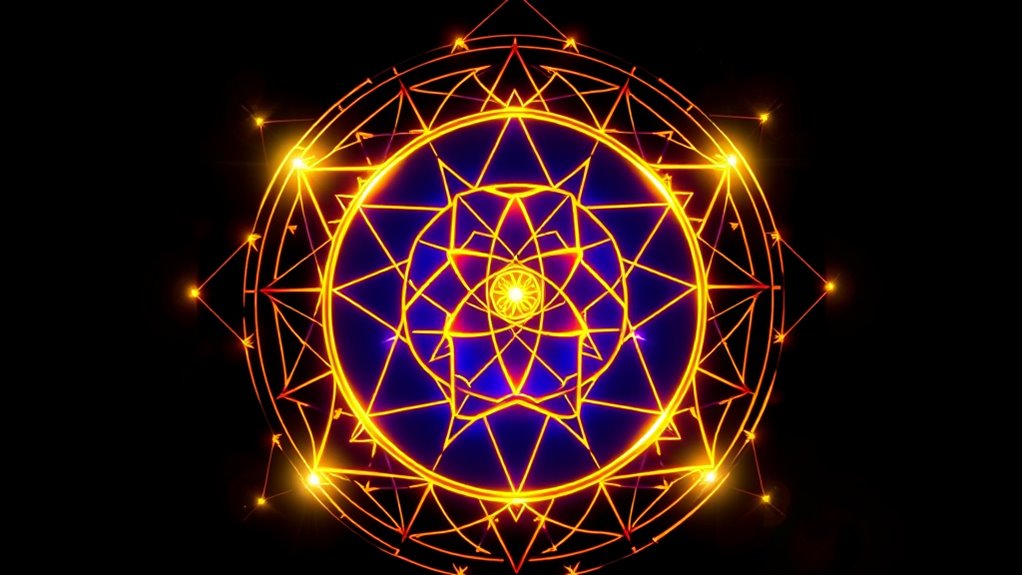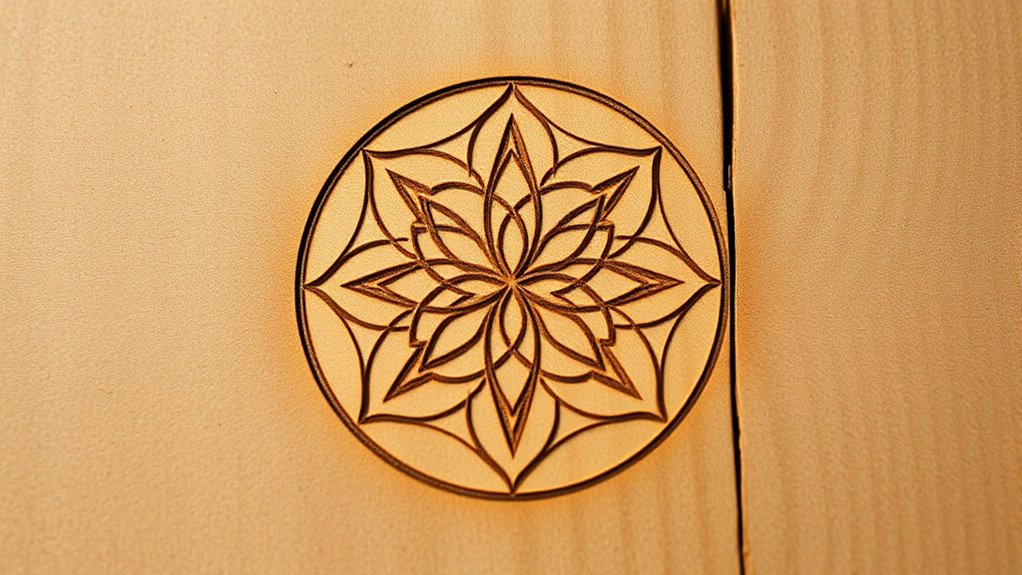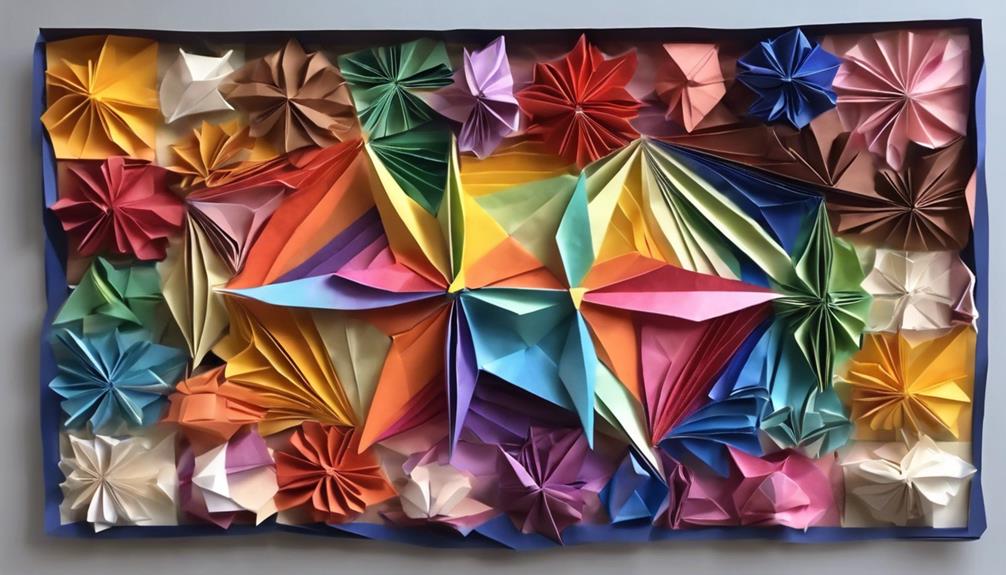Sacred geometry explains how basic shapes, like circles, triangles, and squares, reflect universal harmony and divine principles. These forms symbolize interconnectedness, balance, and wholeness, often incorporating sacred ratios like the Golden Ratio to enhance their spiritual significance. When you understand these shapes and proportions, you see how they represent the universe’s divine order. Exploring further reveals the deeper meanings behind these patterns and their influence on art, architecture, and spirituality.
Key Takeaways
- Shapes in sacred geometry, like circles, triangles, and squares, symbolize universal concepts such as wholeness, stability, and order.
- Sacred proportions, especially the Golden Ratio, are embedded in shapes to represent divine harmony and aesthetic beauty.
- Circles embody infinity and unity, while triangles signify stability and spiritual connection.
- Combining shapes creates patterns that reflect interconnectedness and divine harmony in the universe.
- Visual contrast enhances the perception of these symbolic shapes, emphasizing their spiritual and universal meanings.

Have you ever wondered why certain shapes and patterns appear repeatedly in nature, art, and architecture? These recurring forms aren’t random; they’re rooted in the fundamental principles of sacred geometry. At the core of this study is the idea that specific shapes carry symbolic meanings—geometric symbolism—that reflect the universe’s divine order. By understanding these shapes, you gain insight into how ancient cultures perceived harmony, balance, and interconnectedness. Sacred proportions, like the Golden Ratio, are often embedded within these forms, serving as a blueprint for beauty and spiritual significance. They’re not just visual tools but representations of universal truths that resonate deeply with us on a subconscious level. The use of high contrast ratios in visual design enhances the perception of depth and clarity, allowing these symbolic shapes to stand out more vividly.
As you explore sacred geometry, you’ll notice that shapes such as circles, triangles, and squares aren’t just basic forms—they symbolize profound concepts. The circle, for instance, embodies wholeness, unity, and infinity, reminding you of the cyclical nature of life and the universe. Triangles, especially equilateral ones, often symbolize stability and harmony, connecting the physical with the spiritual. Squares and rectangles, meanwhile, represent order, structure, and groundedness. These shapes, when combined or repeated, create complex patterns that are both aesthetically pleasing and spiritually meaningful. They serve as visual representations of sacred proportions, ensuring that each element aligns with a divine ratio that enhances its symbolic power.
Frequently Asked Questions
How Does Sacred Geometry Influence Modern Design?
You see how mathematical patterns and visual symbolism shape modern design. Sacred geometry influences your choices by providing harmonious proportions and balanced compositions. Whether in architecture, logos, or art, these shapes evoke a sense of connection and spirituality. You might notice that designers use sacred geometry to create visually appealing, meaningful spaces and objects that resonate on a deeper level, making your environment more inspiring and engaging.
Are There Specific Cultures That Emphasize Sacred Shapes More?
You’ll find that many cultures emphasize sacred shapes through cultural symbolism and architectural significance. For example, ancient Egypt used pyramids for spiritual and funerary purposes, while Hindu and Buddhist traditions incorporate mandalas and yantras for meditation. In Western architecture, sacred geometry influences churches and cathedrals, reflecting divine proportions. These shapes embody deeper spiritual meanings, highlighting their importance across various societies and their enduring influence on design and symbolism today.
Can Anyone Learn to Recognize Sacred Geometry in Nature?
Imagine walking through a forest, noticing the spiral of a snail shell or the hexagon patterns on a honeycomb. Anyone can learn to recognize sacred geometry in nature through pattern recognition and observing natural symbols. With practice, you’ll start seeing these shapes everywhere—on flowers, shells, and even galaxies. It’s about training your eye to notice the subtle, universal designs that connect all living things.
What Is the History Behind the Flower of Life?
You might wonder about the history behind the flower of life. This symbol, rooted in geometric symbolism, dates back thousands of years, with origins in ancient cultures like Egypt and Mesopotamia. Its intricate design represents interconnectedness and unity. Over time, its historical origins have been linked to spiritual and philosophical teachings, making it a powerful symbol that continues to inspire those interested in sacred geometry today.
How Do Sacred Shapes Relate to Spiritual Practices?
You can see that sacred shapes play a essential role in spiritual practices by guiding meditative practices and promoting energy alignment. When you focus on these geometric forms, they help center your mind and connect you to higher consciousness. By visualizing or contemplating these shapes, you enhance your spiritual awareness, balance your energy, and deepen your meditation, making sacred geometry a powerful tool for inner growth and harmony.
Conclusion
Remember, understanding sacred geometry isn’t just about shapes—it’s about connecting with the universe’s deeper wisdom. As the saying goes, “The whole is greater than the sum of its parts.” By exploring these sacred forms, you open yourself to greater harmony and insight. Keep an open mind and stay curious; the more you learn, the more you’ll see the divine in everyday life. Embrace the journey, and let sacred geometry guide you.










